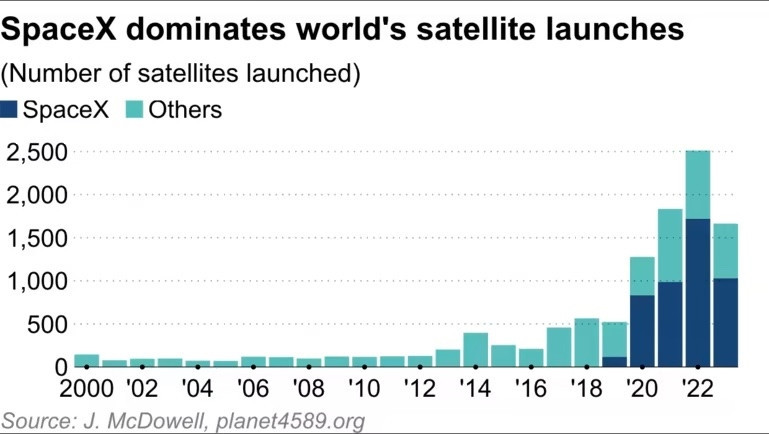The number of satellite broadband users is expected to double worldwide, rising from 71 million in 2022 to 153 million in 2031, while the market size is estimated to increase 13-fold to its current size.
SpaceX's presence in the global satellite internet business continued to grow this year as the company showed its "passionate" investment efforts in this growing market.
On June 20, CEO Elon Musk met with Indian Prime Minister Narendra Modi to propose his desire to provide satellite Internet service in the country of a billion people. The American billionaire emphasized that satellite communication can help eliminate Internet gaps in the most remote villages. India has a population of 1.4 billion, but only 2% of households have high-speed fixed Internet access.
SpaceX rockets can carry up to 60 satellites in a single launch. According to data from Jonathan McDowell, an astrophysicist at the Harvard-Smithsonian Center for Astrophysics, as of the end of the first 6 months of 2023, Elon Musk's company has put more than 1,000 satellites into orbit, accounting for 60% of the satellites launched worldwide.

SpaceX is the company that has launched the most satellites into orbit in the world since 2019.
In total, SpaceX has sent nearly 5,000 satellites into space since 2019 and has applied for permission to operate a total of 42,000 satellites. The company currently faces virtually no worthy competitors.
SpaceX's Starlink satellites can provide high-speed Internet access at altitudes of 300 to 600 kilometers above the Earth's surface, much lower than meteorological and other satellites that typically operate in orbits of about 36,000 kilometers. To access the Internet, Starlink customers only need to install a 50 x 30 cm antenna.
Self-driving cars are the main customers
Starlink has grown primarily in the business-to-business (B2B) segment. The service has also played a key role in Ukraine, where many ground communications facilities were destroyed in clashes between the two sides.
Starlink's internet speeds are comparable to terrestrial service and are about 40% faster than regular broadband in the UK, and twice as fast as in Australia, according to Ookla, a US internet speed test provider.
But by eliminating the need for cables, they have a big advantage in remote areas with poor communications infrastructure. Euroconsult, a space industry consultancy, estimates that the number of satellite broadband users worldwide is expected to double, rising from 71 million in 2022 to 153 million in 2031.
Investment bank Morgan Stanley forecasts the global market for satellite communications services will grow 13-fold between 2020 and 2040, to $95 billion, led by demand from autonomous vehicles. Satellite links are a boon for self-driving cars because they can continuously update software from anywhere, according to Adam Jonas, an analyst at the firm.
However, satellite communications are relatively new and not without risks. OneWeb, a British satellite operator, collapsed in 2020 after running into financial difficulties, before being bailed out by the government.
Even SpaceX isn’t on a completely solid footing. The company has been growing its market, thanks in part to massive subsidies from Washington and project orders from NASA. SpaceX President Gwynne Shotwell said Starlink “will be making money” by 2023.
According to Vietnamnet